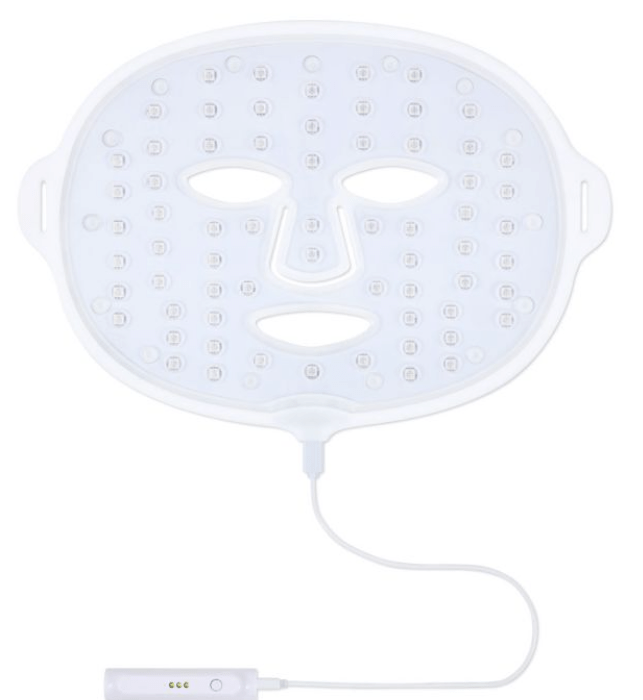When it comes to this season’s must-have accessory, you can forget about the latest it bag or statement shoe, because anyone who’s anyone has been spotted rocking an LED face mask. We’re talking Jessica Alba, Victoria Beckham, Kate Hudson, and Kate Moss. And the entire Kardashian-Jenner klan, of course. The secret to superstar skin, these futuristic face fixers boast major beauty powers and can literally do everything, from boosting collagen production to calming redness and clearing blemishes.
“LED masks are an incredible at-home tool to help rejuvenate skin, improve acne and calm skin”, says Dr. Maryam Zamani, leading oculoplastic surgeon and founder of MZ Skin. “Red/ir led light helps promote collagen and elastin production and has excellent anti-inflammatory properties, while blue/ir light can be used to help diminish p acne skin which contributes to the formation of acne. It’s safe to use on all skin types and the at-home devices can be used all year round!”. Not to mention they work in a matter of minutes, they help reduce cortisol levels, and they’re totally safe and pain-free. Even if you do look like something out of a sci-fi film when using one…
Sound too good to be true? Hip & Healthy tapped Hannah Measures and Laura Ferguson, founders of The Light Salon (which specialises in all things LED facials, FYI) , to find out everything you need to know about LED masks and if they’re worth the hype. Listen in.
What exactly is LED and why is it having such a big moment in beauty?
LED stands for light emitting diode. The benefits are a result of the light, which emits therapeutic wavelengths of light energy into the skin to encourage cells to behave more youthfully, stimulating circulation and the production of everything from elastin to collagen. Red 633nm and near-infrared 830nm are clinically proven to be optimal wavelengths for skin health and rejuvenation, with 830nm achieving the quickest results and greatest levels of customer satisfaction.
It’s the skincare results that draw most people to LED, and for good reason, with wrinkle reduction, breakout control and skin radiance among a long list of benefits! But just as powerful for us is the sense of wellbeing we feel from that daily dose of light.
What’s the biggest misconception about LED?
LED results depend on quality, power (energy), and wavelength accuracy and consistency, as opposed to the number of bulbs used. Whether you have 99 bulbs or 199 bulbs in a device, if the wavelength is inaccurate or inconsistent, the light will not hit the targeted area and in turn won’t have the desired effect on the skin and body. Longer wavelengths such as red 633nm and near-infrared 830nm do penetrate well, reach the dermis, and are clinically proven to be optimal wavelengths for skin health and rejuvenation, with 830nm achieving the quickest results and greatest levels of customer satisfaction.
We work with red 633nm and near-infrared 830nm wavelengths for precisely this reason – not only do they stimulate collagen and elastin production (rejuvenating the complexion), they also penetrate deep into the body, reaching muscles, nerves, and bone, to increase blood flow and target inflammation whilst supporting cellular regrowth and regeneration to help reduce pain and heal injuries.
What are the different colours and what do they do?
Blue (415nm)
Targets and destroys acne bacteria found in the sebaceous glands, which reduces bacteria and the forming of blemishes or pustules. It also regulates oil production, balancing oily skin or t-zone, and increases blood circulation, which helps to eliminate toxins and provide nutrients to the skin. Blue (415nm) light has an anti-inflammatory effect on the skin, which reduces healing time and also prevents post-inflammatory scarring.
Red (633nm)
Stimulates collagen and elastin within the dermis and increases blood flow and oxygenation to the skin, all while delivering nutrients and antioxidants to repair. Increases regeneration so that skin looks and feels plumper, and brighter, with improved density in the dermis to support the ageing process.
Near-Infrared (830nm)
Penetrates deep into the skin and can reach the bone, increasing cellular activity so that cells behave in a more responsive manner. Increases the production of collagen, elastin and hyaluronic acid to maintain the skin’s structure for a more youthful appearance. Near-Infrared (830nm) also reduces inflammation and pain by increasing blood flow and tissue oxygenation, supporting cellular health and repairing damage. In terms of skin tone, it regulates the production of melanin and increases antioxidants and nutrients within the skin. It also balances hormones such as cortisol (the stress hormone), serotonin (the feel-good hormone) and melatonin (our sleep hormone).
What should I know before booking an LED treatment or using an at-home mask?
Preparation of the skin is essential for optimal light absorption and will enhance results. So, whether you’re in-salon or at home, cleanse skin properly. We suggest using our ‘Enzymatic Cleanser & Mask’ and to seal results with the ‘Hydrating Peptide Serum’.
Consistency is also key. LED therapy is like exercise, the more you do the more you gain! Invest in a device or have multiple facials to see real long-lasting and long-term results.

Angela Caglia ‘Crystal LED Face Mask’ – £550 
Dr. Dennis Gross ‘DRX Spectralite Faceware Pro’ – £430 
The Light Salon ‘Boost LED Face Mask’ – £395 
MZ Skin ‘Light-Therapy Golden Facial Treatment Device’ – £390 
Omnilux Clear LED Face Mask – £299 
No7 LABORATORIES ‘Age-Defying LED Mask’ – £149.95
words by Frankie Rozwadowska














